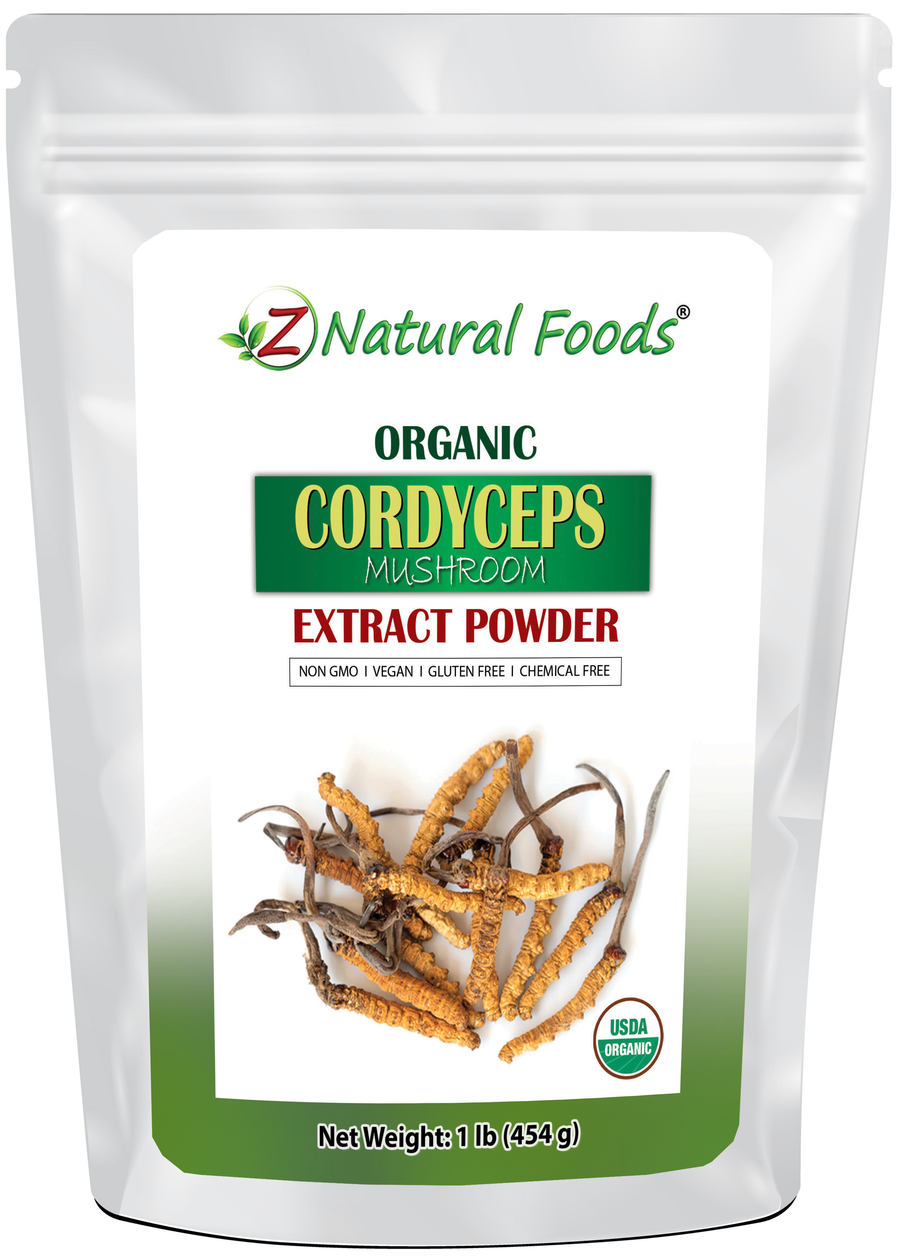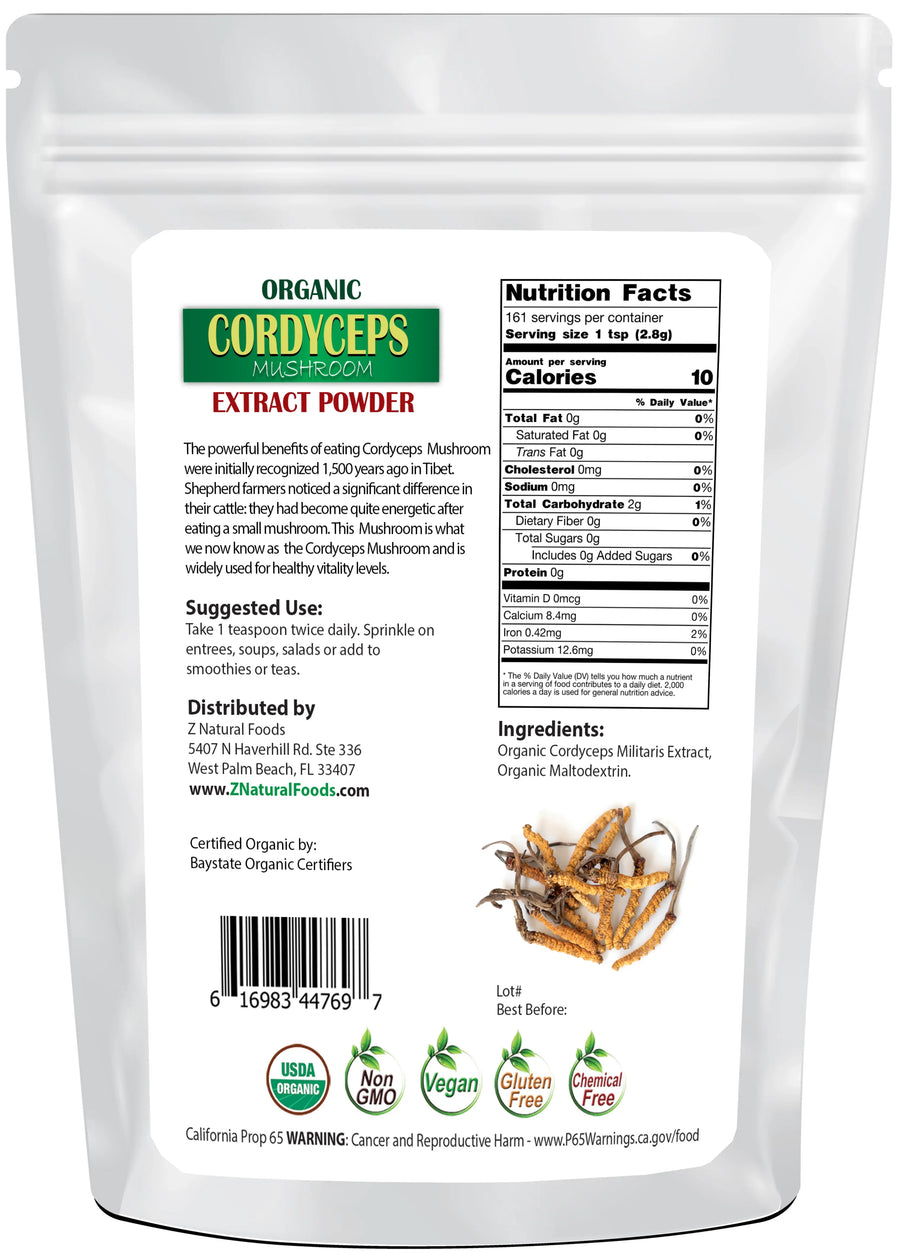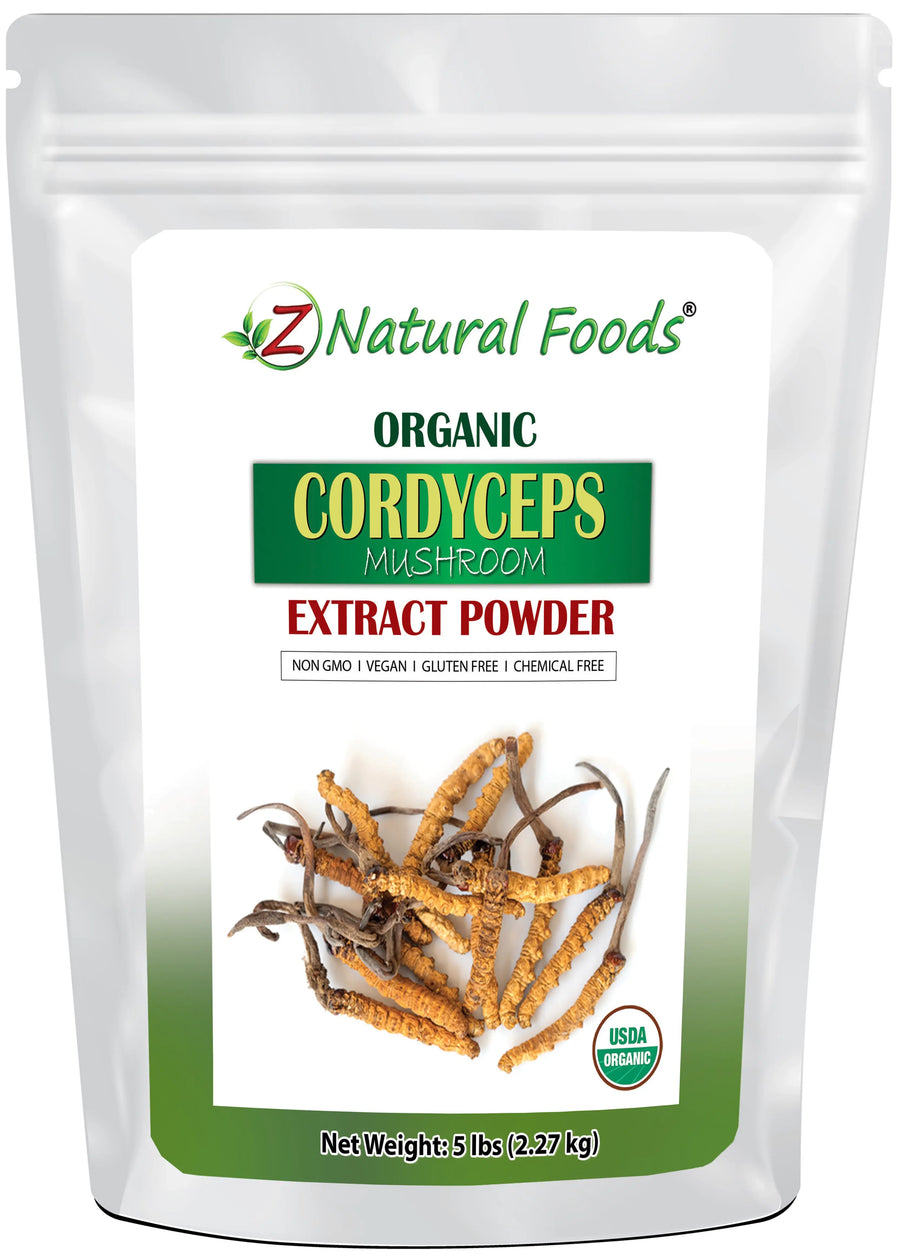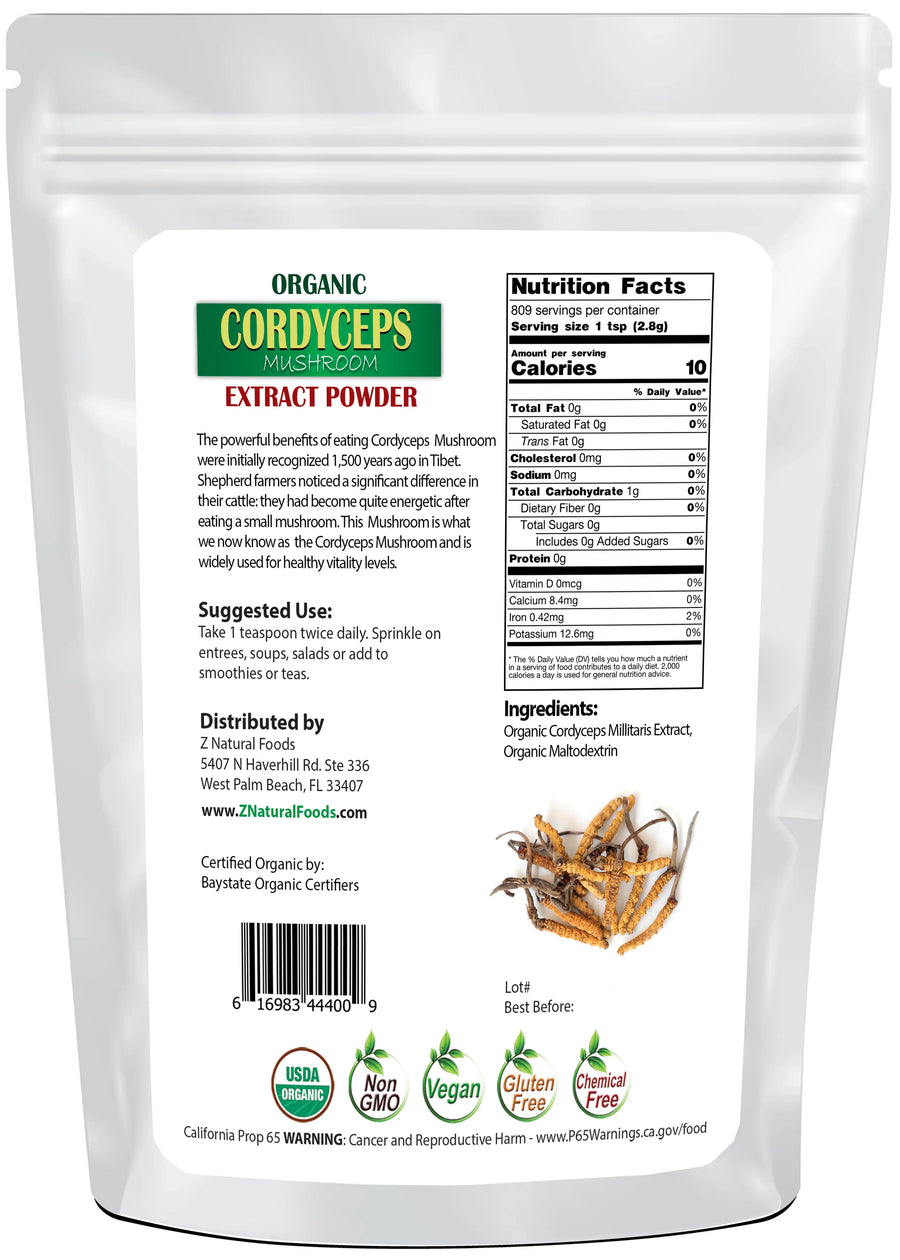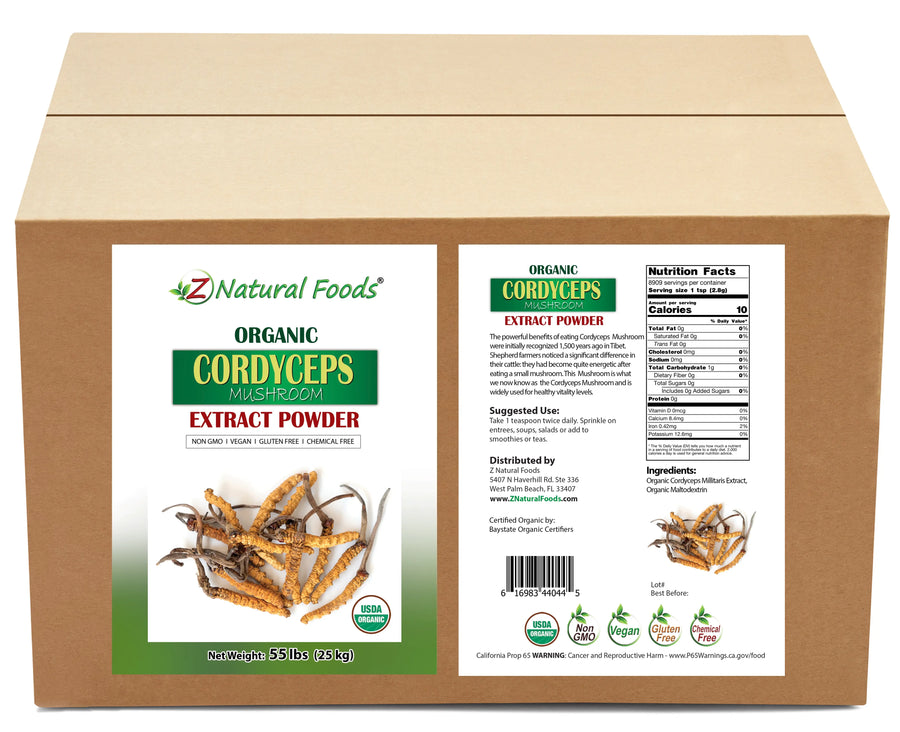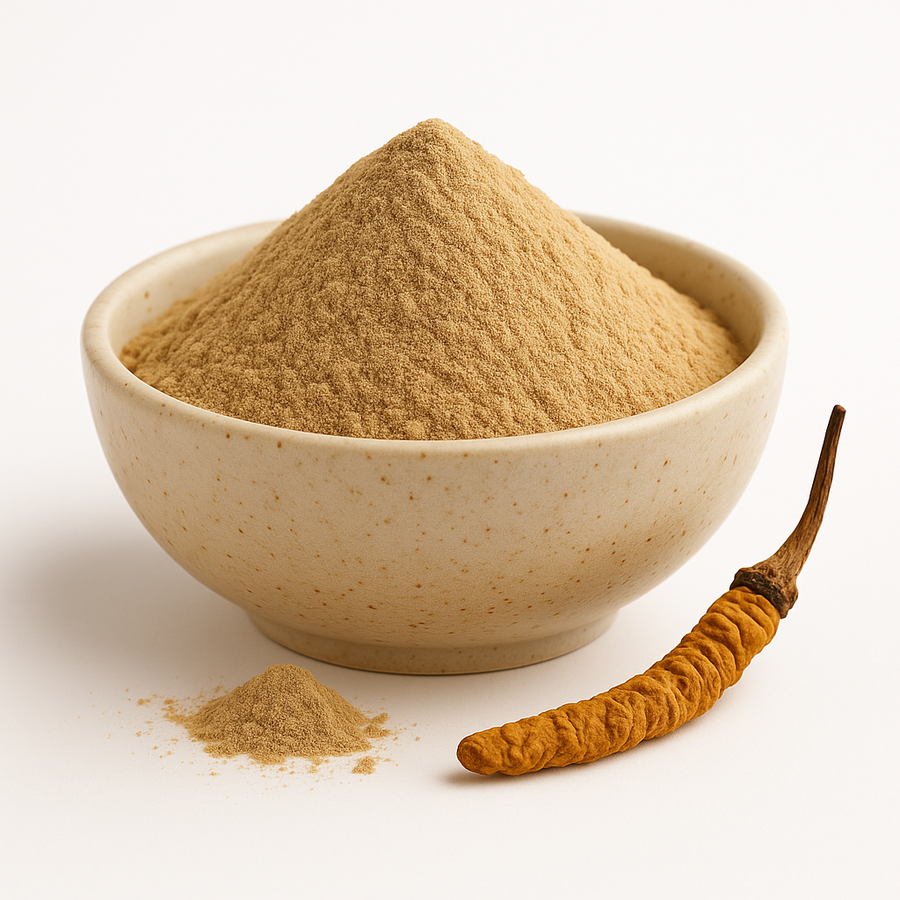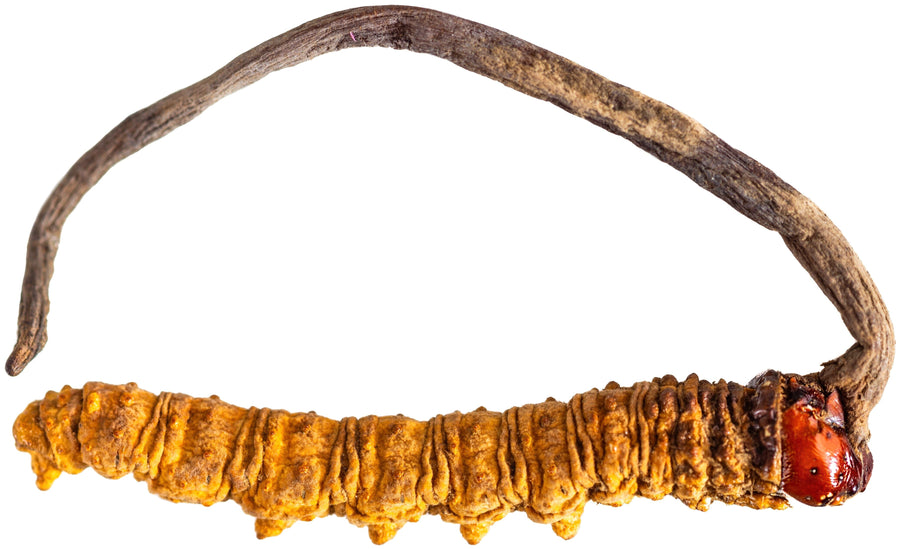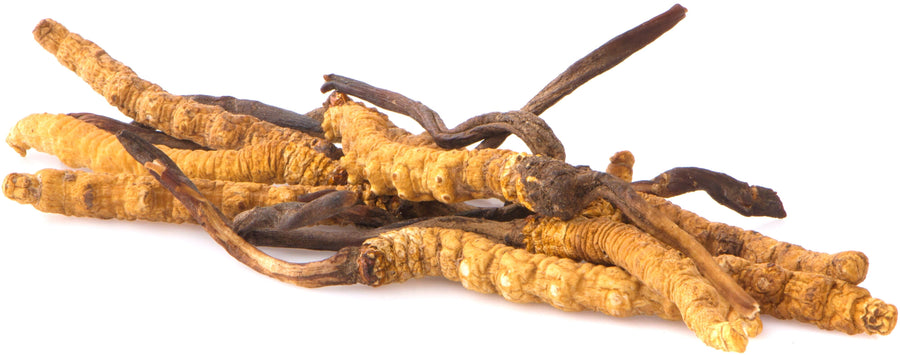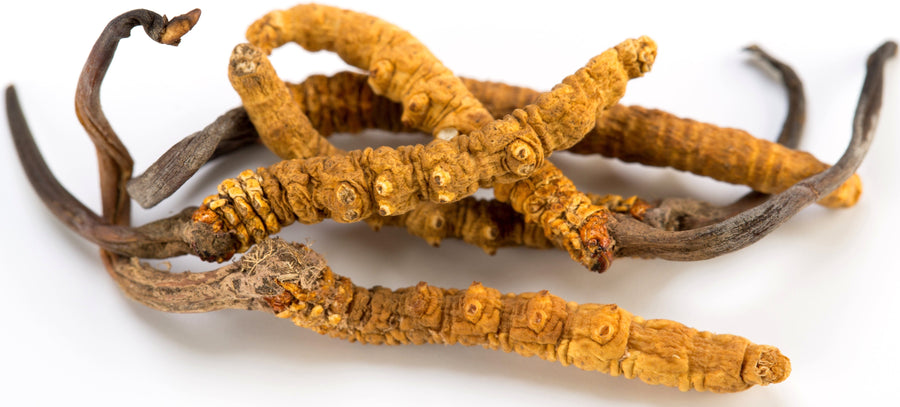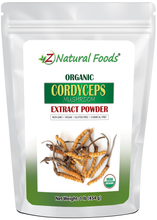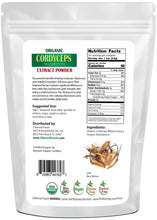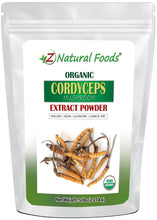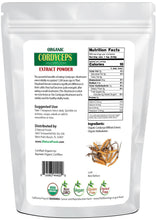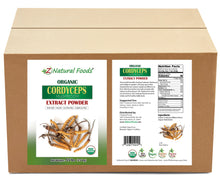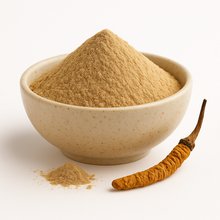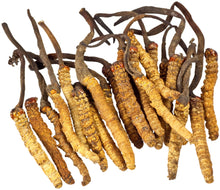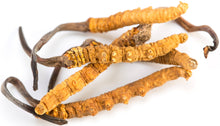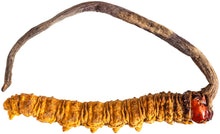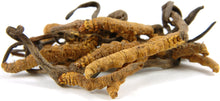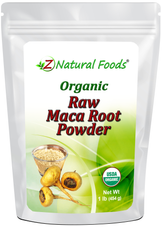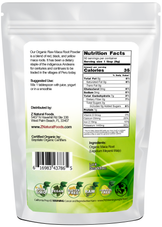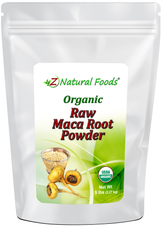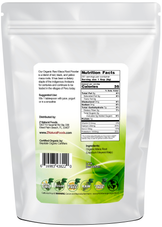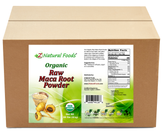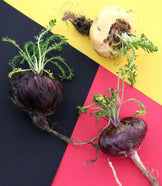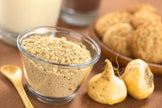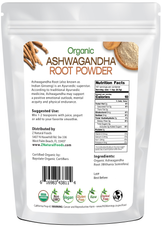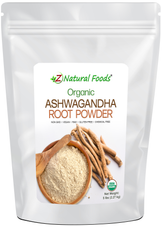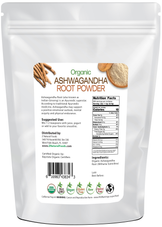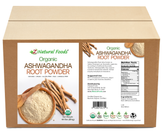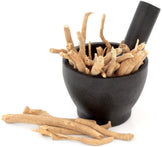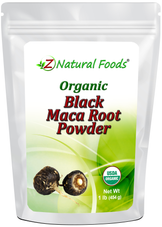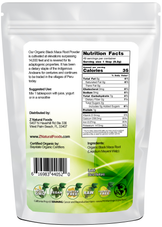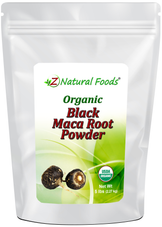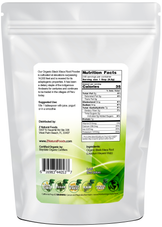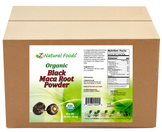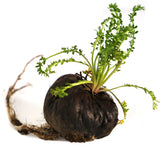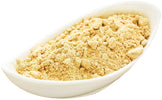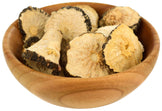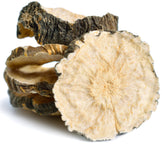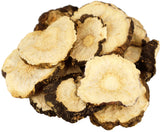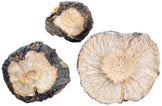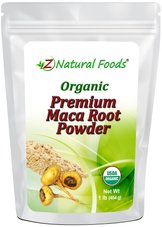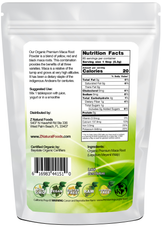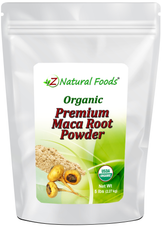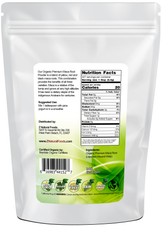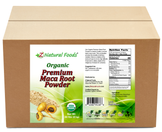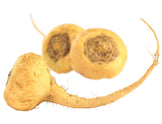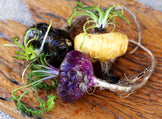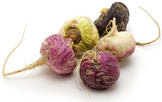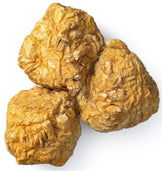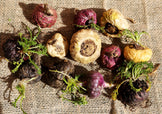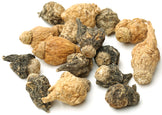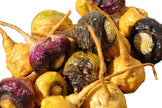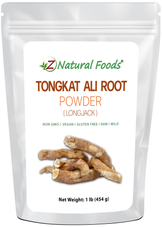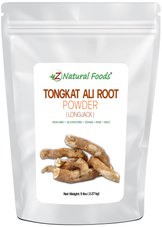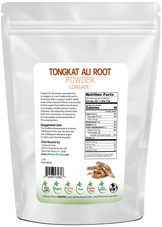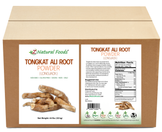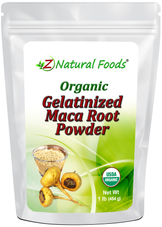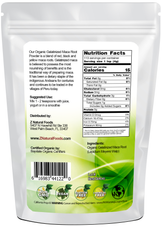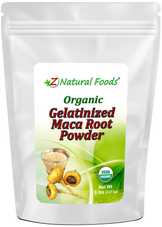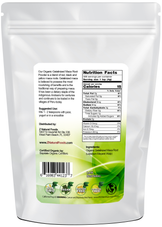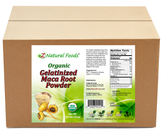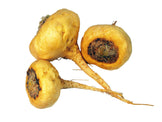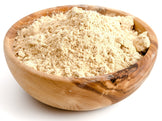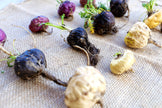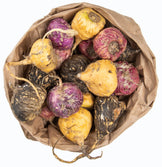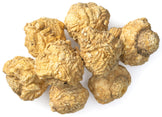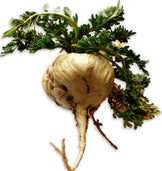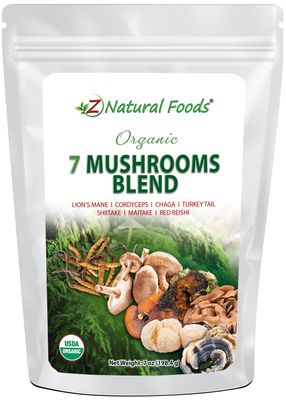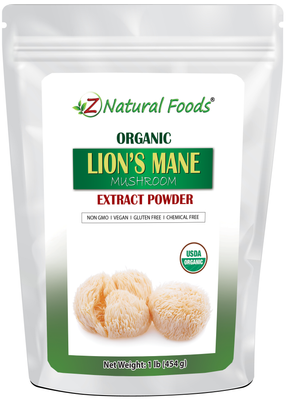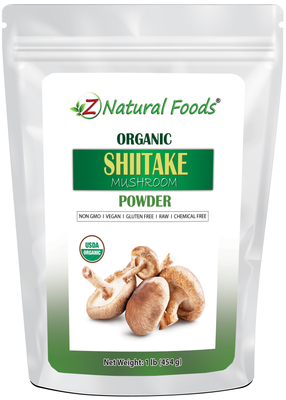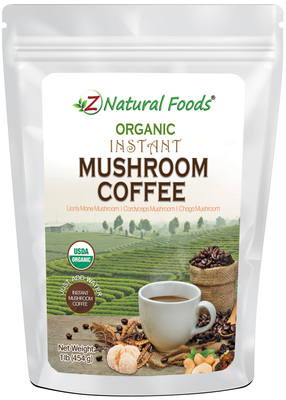About Product
Organic Cordyceps Mushroom Extract Powder is made from the fruiting bodies of the cordyceps mushroom, carefully dried and ground into a fine powder. It has an earthy, slightly nutty flavor that blends well into teas, coffees, smoothies, and a variety of recipes.
Convenient and shelf-stable, this versatile powder is easy to mix and can be used in both hot and cold beverages. Its unique taste and adaptability make it a popular choice for those exploring mushroom-based ingredients in their daily routines.
Some research suggests that Cordyceps may contain the following constituents:
- Minerals: Magnesium, Zinc, Copper, Manganese, Selenium
- Vitamins: Thiamin, Riboflavin, Vitamin B-6, Vitamin B12, Vitamin E, Vitamin K
- Amino Acids: Cysteic Acid, Aspartic Acid, Methionine, Threonine, Serine, Glutamic Acid, Proline, Glycine, Alanine, Valine, Isoleucine, Leucine, Tyrosine, Phenylalanine, Lysine, Histidine, Arginine
- Fatty Acids: Palmitic Acid, Palmitoleic Acid, Stearic Acid, Oleic Acid, Linoleic Acid, Linolenic Acid
- Phytochemicals: Nucleosides, Cordycepin, Adenosine, Polysaccharides, Exopolysaccharide Fraction, Acid Polysaccharide, CPS-1, CPS-2, Sterols
- Nucleobases: Cytosine, Uracil, Thymine, Adenine, Guanine, Hypoxanthine,
- Nucleotides: Uridine-5-Monophosphate, Adenosine-5-Monophosphate, Guanosine-5-Monophosphate
- Peptides: Cordymin, Cordycedipeptide A, Cordyceamides A & B
Miscellaneous Facts about Our Organic Cordyceps Mushroom Extract Powder:
Suggested Use: Take one teaspoon twice daily. Sprinkle on entrees, soups, salads, or add to smoothies or teas.
Mixing suggestion: To increase flavor and nutritional profile, combine with our astragalus root, fo-ti root, and lucuma powder.
Botanical Name: Cordyceps Militaris
Common Names: Deer Fungus, Semitake, JinShuiBao, Caterpillar Fungus, Dong Chong Xia Cao Tochukas, Chongcao, Deer Fungus Parasite
Parts Used: Fruiting body
Ingredients: Organic Cordyceps Mushroom Extract, Organic Maltodextrin.
Certifications: Certified USDA Organic
For additional constituent information, visit:
- http://www.hindawi.com/journals/ecam/2015/575063/
- http://www.ncbi.nlm.nih.gov/pmc/articles/PMC3755201/
How to Maintain Optimum Freshness
- This product is packaged in airtight stand-up, resealable foil pouches for optimum freshness.
- Once opened, push the air out of the pouch before resealing it to preserve maximum potency.
- Keep your powder in a cool, dark, dry place.
This product is 100% natural and minimally processed:
Taste, smell, texture, and color vary from batch to batch. Go here to learn why our products may naturally vary.
The important protections we take to bring you safe and nutritious superfoods:
Please go here to discover the essential steps we take to deliver fresh, quality nutrition.
Bulk Quantities?
Need to order a large quantity of our products? We are happy to help! Please get in touch with our Bulk department to discuss the details.
* Product packaging, pictures, and origin may vary.
Sources & References
1. Holliday, John; Cleaver, Matt; (2008). "Medicinal Value of the Caterpillar Fungi Species of the Genus Cordyceps (Fr.) Link (Ascomycetes). A Review" (PDF). International Journal of Medicinal Mushrooms (New York: Begell House) 10 (3): 219. doi:10.1615/IntJMedMushr.v10.i3.30. ISSN 1521-9437.
2. Winkler, D. 2008a. Yartsa Gunbu (Cordyceps sinensis) and the Fungal Commodification of the Rural Economy in Tibet AR. Economic Botany 63.2: 291"“306
3. Halpern, Georges M. (2007). Healing Mushrooms. Square One Publishers. pp. 65"“86. ISBN 978-0-7570-0196-3.
4. "Neurophilosophy: Brainwashed by a parasite". 2006-11-20. Retrieved 2008-07-02.
5. Hughes, D. P.; Wappler, T.; Labandeira, C. C. (2010). "Ancient death-grip leaf scars reveal ant-fungal parasitism". Biology Letters 7 (1): 67"“70. doi:10.1098/rsbl.2010.0521. PMC 3030878. PMID 20719770. edit
6. Sung, Gi-Ho; Nigel L. Hywel-Jones, Jae-Mo Sung, J. Jennifer Luangsa-ard, Bhushan Shrestha and Joseph W. Spatafora (2007). "Phylogenetic classification of Cordyceps and the clavicipitaceous fungi". Stud Mycol 57 (1): 5"“59. doi:10.3114/sim.2007.57.01. PMC 2104736. PMID 18490993.
7. Holliday, John; Cleaver, Phillip; Lomis-Powers, Megan; Patel, Dinesh (2004). "Analysis of Quality and Techniques for Hybridization of Medicinal Fungus Cordyceps sinensis (Berk.)Sacc. (Ascomycetes)" (PDF). International Journal of Medicinal Mushrooms (New York: Begell House) 6 (2): 152. doi:10.1615/IntJMedMushr.v6.i2.60. ISSN 1521-9437.
8. Holliday, John (2005). "Cordyceps" (PDF). In Coates, Paul M. Encyclopaedia of Dietary Supplements 1. Marcel Dekker. pp. 4 of Cordyceps Chapter.
9. Cordyceps information from Drugs.com.
10. Khan MA, Tania M, Zhang D, Chen H (May 2010). "Cordyceps Mushroom: A Potent Anticancer Nutraceutical". The Open Nutraceuticals Journal 3: 179"“183. doi:10.2174/1876396001003010179.
11. Liu, Wei-Chung; Wang, Shu-Chi; Tsai, Min-Lung; Chen, Meng-Chi; Wang, Ya-Chen; Hong, Ji-Hong; McBride, William H.; Chiang, CS (2006-12). "Protection against Radiation-Induced Bone Marrow and Intestinal Injuries by Cordyceps sinensis, a Chinese Herbal Medicine". Radiation Research 166 (6): 900"“907. doi:10.1667/RR0670.1. PMID 17149981.
12. Ko WS, Hsu SL, Chyau CC, Chen KC, Peng RY (July 2009). "Compound Cordyceps TCM-700C exhibits potent hepatoprotective capability in animal model". Fitoterapia 81 (1): 1"“7. doi:10.1016/j.fitote.2009.06.018. PMID 19596425.
13. Nishizawa K, Torii K, Kawasaki A et al. (September 2007). "Antidepressant-like effect of Cordyceps sinensis in the mouse tail suspension test". Biol. Pharm. Bull. 30 (9): 1758"“1762. doi:10.1248/bpb.30.1758. PMID 17827735.
14. Kiho T, Hui J, Yamane A, Ukai S (December 1993). "Polysaccharides in fungi. XXXII. Hypoglycemic activity and chemical properties of a polysaccharide from the cultural mycelium of Cordyceps sinensis". Biol. Pharm. Bull. 16 (12): 1291"“1293. doi:10.1248/bpb.16.1291. PMID 8130781.
15. Kiho T, Yamane A, Hui J, Usui S, Ukai S (February 1996). "Polysaccharides in fungi. XXXVI. Hypoglycemic activity of a polysaccharide (CS-F30) from the cultural mycelium of Cordyceps sinensis and its effect on glucose metabolism in mouse liver". Biol. Pharm. Bull. 19 (2): 294"“296. doi:10.1248/bpb.19.294. PMID 8850325.
16. Zhao CS, Yin WT, Wang JY et al. (June 2002). "CordyMax Cs-4 improves glucose metabolism and increases insulin sensitivity in normal rats". J Altern Complement Med 8 (3): 309"“314. doi:10.1089/10755530260127998. PMID 12165188.
17. Lo HC, Tu ST, Lin KC, Lin SC (April 2004). "The anti-hyperglycemic activity of the fruiting body of Cordyceps in diabetic rats induced by nicotinamide and streptozotocin". Life Sci. 74 (23): 2897"“2908. doi:10.1016/j.lfs.2003.11.003. PMID 15050427.
18. Li SP, Zhang GH, Zeng Q et al. (June 2006). "Hypoglycemic activity of polysaccharide, with antioxidation, isolated from cultured Cordyceps mycelia". Phytomedicine 13 (6): 428"“433. doi:10.1016/j.phymed.2005.02.002. PMID 16716913.
19. Mackay, Duncan (2001-07-24). "Ma's army on the march again". The Guardian. Retrieved 2010-12-04.
20. Winkler, Daniel (2008). "Yarsa Gunbu (Cordyceps sinensis) and the Fungal Commodification of the Rural Economy in Nepal". Economic Botany 62 (3): 291"“305. doi:10.1007/s12231-008-9038-3
21. Chen J, Zhang W, Lu T, et al. Morphological and genetic characterization of a cultivated Cordyceps sinensis fungus and its polysaccharide component possessing antioxidant property in H22 tumor-bearing mice. Life Sci 5-1-2006;78(23):2742-2748.
22. Kim HG, Shrestha B, Lim SY, et al. Cordycepin inhibits lipopolysaccharide-induced inflammation by the suppression of NF-kappaB through Akt and p38 inhibition in RAW 264.7 macrophage cells. Eur J Pharmacol 9-18-2006;545(2-3):192-199.
23. Kunwar RM, Nepal BK, Kshhetri HB, et al. Ethnomedicine in Himalaya: a case study from Dolpa, Humla, Jumla and Mustang districts of Nepal. J Ethnobiol Ethnomedicine. 2006;2:27.
24. Lee H, Kim YJ, Kim HW, et al. Induction of apoptosis by Cordyceps militaris through activation of caspase-3 in leukemia HL-60 cells. Biol Pharm Bull. 2006;29(4):670-674.
25. Li FH, Liu P, Xiong WG, Xu GF. [Effects of Cordyceps sinensis on dimethylnitrosamine-induced liver fibrosis in rats]. Zhong.Xi.Yi.Jie.He.Xue.Bao. 2006;4(5):514-517.
26. Li SP, Yang FQ, Tsim KW. Quality control of Cordyceps sinensis, a valued traditional Chinese medicine. J Pharm Biomed.Anal. 8-28-2006;41(5):1571-1584.
27. Li SP, Zhang GH, Zeng Q, et al. Hypoglycemic activity of polysaccharide, with antioxidation, isolated from cultured Cordyceps mycelia. Phytomedicine 2006;13(6):428-433.
28. Liu WC, Wang SC, Tsai ML, et al. Protection against radiation-induced bone marrow and intestinal injuries by Cordyceps sinensis, a Chinese herbal medicine. Radiat.Res 2006;166(6):900-907.
29. Rukachaisirikul V, Chantaruk S, Tansakul C, et al. A cyclopeptide from the Insect pathogenic fungus Cordyceps sp. BCC 1788. J Nat Prod 2006;69(2):305-307.
30. Shao G. [Treatment of hyperlipidemia with cultivated Cordyceps--a double-blind, randomized placebo control trial]. Zhong.Xi.Yi.Jie.He.Za Zhi. 1985;5(11):652-4, 642.
31. Wu WC, Hsiao JR, Lian YY, et al. The apoptotic effect of cordycepin on human OEC-M1 oral cancer cell line. Cancer Chemother.Pharmacol 10-10-2006.
32. Wu Y, Sun H, Qin F, et al. Effect of various extracts and a polysaccharide from the edible mycelia of Cordyceps sinensis on cellular and humoral immune response against ovalbumin in mice. Phytother Res 2006;20(8):646-652.
33. Yoo O, Lee DH. Inhibition of sodium glucose cotransporter-I expressed in Xenopus laevis oocytes by 4-acetoxyscirpendiol from Cordyceps takaomantana (anamorph = Paecilomyces tenuipes). Med Mycol 2006;44(1):79-85.
34. Yu HM, Wang BS, Huang SC, Duh PD. Comparison of protective effects between cultured Cordyceps militaris and natural Cordyceps sinensis against oxidative damage. J Agric.Food Chem 4-19-2006;54(8):3132-3138.
35. Zhang G, Huang Y, Bian Y, et al. Hypoglycemic activity of the fungi Cordyceps militaris, Cordyceps sinensis, Tricholoma mongolicum, and Omphalia lapidescens in streptozotocin-induced diabetic rats. Appl Microbiol Biotechnol 2006;72(6):1152-1156.
36. http://www.ncbi.nlm.nih.gov/pubmed/16354395
37. http://www.ncbi.nlm.nih.gov/pubmed/20650308
38. http://www.ncbi.nlm.nih.gov/pubmed/23189667
39. http://www.ncbi.nlm.nih.gov/pubmed/12736514
40. http://www.ncbi.nlm.nih.gov/pubmed/1392475
41. http://www.ncbi.nlm.nih.gov/pubmed/1597083
42. http://www.ncbi.nlm.nih.gov/pubmed/9764768
43. http://www.alohamedicinals.com/Cordy_Article.pdf
44. http://www.hindawi.com/journals/ecam/2015/575063/
45. http://www.ncbi.nlm.nih.gov/pmc/articles/PMC3755201/
* Reviews & Success Stories Disclaimer
Product reviews solely reflect the views and opinions expressed by the contributors and not those of Z Natural Foods. Z Natural Foods does not verify or endorse any claims made in these reviews. Statements have not been evaluated by the FDA and are not intended to diagnose, treat, cure, or prevent any disease or health condition.REFERRAL PROGRAM
Share your personal link to your friends and welcome them with rewards. Claim yours when they make their first purchase.

GIVE
$10 off discount

GET
$10 off discount
